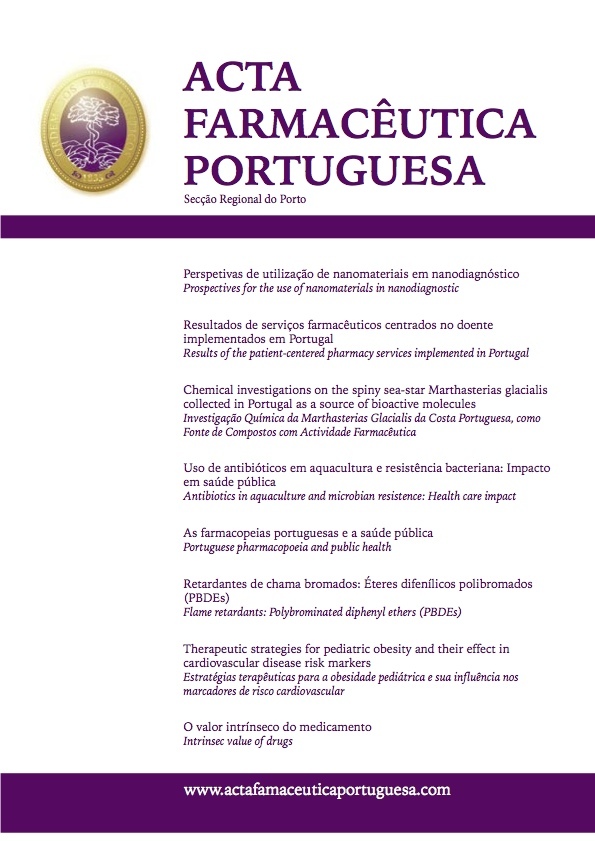Chemical investigations on the spiny sea-star Marthasterias glacialis collected in Portugal as a source of bioactive molecules
Abstract
Marine organisms are increasingly regarded as a promising source of bioactive molecules for human pharmacotherapy, being used in conditions such as cancer, inflammation, infection and pain.
Marthasterias glacialis, also known as the spiny sea-star, is an echinoderm common in the Portuguese coast, however little information is available regarding its chemical constituents.
In this work, the chemistry of this organism is reviewed taking into account the latest reports on several classes of natural products, namely carotenoids, sterols, fatty acids and amino acids.References
Albericio, F., M. Álvarez, C. Cuevas, A. Francesch, D. Pla and J. Tulla-Puche (2010). The sea as a source of new drugs. Molecular imaging for integrated medical therapy and drug development, Springer: 237-249.
Blair, S. N., D. M. Capuzzi, S. O. Gottlieb, T. Nguyen, J. M. Morgan and N. B. Cater (2000). "Incremental reduction of serum total cholesterol and low-density lipoprotein cholesterol with the addition of plant stanol ester-containing spread to statin therapy." American Journal of Cardiology 86(1): 46-52.
Cragg, G. M. and D. J. Newman (2013). "Natural products: A continuing source of novel drug leads." Biochimica et Biophysica Acta (BBA)-General Subjects.
Das, U. N. (2010). Essential Fatty Acids: Biochemistry and Physiology. Metabolic Syndrome Pathophysiology, Wiley-Blackwell: 181-200.
Delgado-Vargas, F., A. Jiménez and O. Paredes-López (2000). "Natural pigments: carotenoids, anthocyanins, and betalains—characteristics, biosynthesis, processing, and stability." Critical Reviews in Food Science and Nutrition 40(3): 173-289.
Jha, R. K. and X. Zi-rong (2004). "Biomedical compounds from marine organisms." Marine drugs 2(3): 123-146.
Katan, M. B., S. M. Grundy, P. Jones, M. Law, T. Miettinen and R. Paoletti (2003). Efficacy and safety of plant stanols and sterols in the management of blood cholesterol levels. Mayo Clinic Proceedings, Elsevier.
Liu, C.-L., Y.-S. Huang, M. Hosokawa, K. Miyashita and M.-L. Hu (2009). "Inhibition of proliferation of a hepatoma cell line by fucoxanthin in relation to cell cycle arrest and enhanced gap junctional intercellular communication." Chemico-biological interactions 182(2): 165-172.
Mariutti, L. R., D. M. Pereira, A. Z. Mercadante, P. Valentão, N. Teixeira and P. B. Andrade (2012). "Further Insights on the Carotenoid Profile of the Echinoderm Marthasterias glacialis L." Marine drugs 10(7): 1498-1510.
Pereira, D. M., G. Correia-da-Silva, P. Valentão, N. Teixeira and P. B. Andrade (2011). Marine metabolomics in cancer chemotherapy. OMICS: Biomedical Perspectives and Applications D. Barh, CRC Press.
Pereira, D. M., G. Correia-da-Silva, P. Valentão, N. Teixeira and P. B. Andrade (2013a). "GC-MS Lipidomic Profiling of the Echinoderm Marthasterias glacialis and Screening for Activity against Human Cancer and Non-cancer Cell Lines." Comb Chem High Throughput Screen Epub ahead of print.
Pereira, D. M., G. Correia-da-Silva, P. Valentão, N. Teixeira and P. B. Andrade (2014a). "The anti-inflammatory effect of unsaturated fatty acids and ergosta-7,22-dien-3-ol from the echinoderm Marthasterias glacialis involves prevention of CHOP pathway-mediated ER-stress and NF-κB activation." Plos One in press.
Pereira, D. M., G. Correia-da-Silva, P. Valentão, N. Teixeira and P. B. Andrade (2014b). "Palmitic acid and ergosta-7,22-dien-3-ol contribute to the ER-stress-mediated apoptotic effect and cell cycle arrest of an extract from Marthasterias glacialis L. in neuroblastoma cells." Marine drugs 12: 54-68.
Pereira, D. M., P. Valentão and P. B. Andrade (2013b). Lessons from the sea: distribution, SAR and molecular mechanisms of anti-inflammatory drugs from marine organisms. Studies in Natural Products Chemistry (Bioactive Natural Products). Atta-ur-Rahman. The Netherlands, Elsevier Science Publishers.
Pereira, D. M., J. Vinholes, P. G. de Pinho, P. Valentão, T. Mouga, N. Teixeira and P. B. Andrade (2012). "A gas chromatography-mass spectrometry multi-target method for the simultaneous analysis of three classes of metabolites in marine organisms." Talanta.
Peterson, D. W. (1951). "Effect of soybean sterols in the diet on plasma and liver cholesterol in chicks." Proceedings of the Society of Experimental Biology and Medicine 78(1): 143-147.
Pollak, O. J. (1953). "Reduction of blood cholesterol in man." Circulation 7(5): 702-706.
Stahl, W. and H. Sies (1998). "The role of carotenoids and retinoids in gap junctional communication." International Journal for Vitamin and Nutrition Research. 68(6): 354.
Tanaka, T., M. Shnimizu and H. Moriwaki (2012). "Cancer chemoprevention by carotenoids." Molecules 17(3): 3202-3242.


